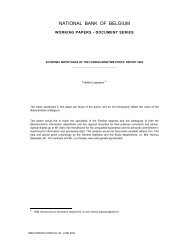A multi-factor model for the valuation and risk management of ...
A multi-factor model for the valuation and risk management of ...
A multi-factor model for the valuation and risk management of ...
Create successful ePaper yourself
Turn your PDF publications into a flip-book with our unique Google optimized e-Paper software.
5 Conclusions<br />
We propose a framework to value dem<strong>and</strong> deposit accounts <strong>and</strong> to assess <strong>the</strong>ir interest rate <strong>risk</strong>.<br />
We add to <strong>the</strong> literature by proposing a <strong>multi</strong>-<strong>factor</strong> ‡exible-a¢ ne joint yield curve deposit rate<br />
<strong>model</strong>, in which bank deposit rates depend on both term structure <strong>and</strong> a deposit spread <strong>factor</strong>.<br />
The <strong>multi</strong><strong>factor</strong> term structure <strong>model</strong> is shown to outper<strong>for</strong>m <strong>the</strong> single <strong>factor</strong> yield curve <strong>model</strong><br />
<strong>and</strong> results in a superior …t <strong>of</strong> actual yield curve dynamics. Describing actual yield curve dynamics<br />
in a no-arbitrage framework well is a crucial feature <strong>of</strong> <strong>the</strong> <strong>model</strong> as <strong>the</strong> yield curve needs to<br />
be simulated <strong>for</strong>ward far in <strong>the</strong> future to per<strong>for</strong>m <strong>the</strong> <strong>valuation</strong> <strong>of</strong> deposit accounts. We present<br />
estimates <strong>of</strong> deposit premiums <strong>and</strong> how <strong>the</strong>y are a¤ected by shifts in <strong>the</strong> yield curve, <strong>for</strong> a series<br />
<strong>of</strong> di¤erent <strong>model</strong> parameters. We also compare our estimates with duration estimates that are<br />
derived from dynamic replicating portfolio approaches, which are currently more popular among<br />
large international banks.<br />
Based on our <strong>model</strong> speci…cation <strong>and</strong> Belgian bank data between December 1994 <strong>and</strong> June 2005, our<br />
estimates imply that deposit premiums are statistically <strong>and</strong> economically signi…cant, but sensitive<br />
to <strong>the</strong> assumed average deposit decay rate. Estimated interest rate elasticities depend to a large<br />
extent on <strong>the</strong> nature <strong>of</strong> <strong>the</strong> yield curve shock (level versus slope shock). For a 0% servicing cost <strong>and</strong><br />
a 15% (40%) decay rate assumption, we …nd that <strong>the</strong> estimated deposit premium averaged across<br />
banks is 23% (10%). The interest rate elasticity <strong>of</strong> our …rst <strong>factor</strong>, which we label a level <strong>factor</strong>,<br />
is -3.8 years (-3.5 years) <strong>and</strong> relatively insensitive to changes in withdrawal rate parameters. We<br />
…nd that, while deposit premiums can be measured relatively accurately, <strong>the</strong>re is more uncertainty<br />
around <strong>the</strong> point estimates <strong>of</strong> estimated interest rate elasticities. Never<strong>the</strong>less, we …nd that deposit<br />
liability values depreciate when market rates increase, <strong>the</strong>reby o¤setting some <strong>of</strong> <strong>the</strong> value losses on<br />
<strong>the</strong> asset side. The precise hedging characteristics depend on <strong>the</strong> decay rate assumptions <strong>and</strong> to a<br />
large extent on <strong>the</strong> nature <strong>of</strong> <strong>the</strong> assumed interest rate shock (level versus slope shock). Variation<br />
in deposit premium <strong>and</strong> IRE estimates across Belgian banks is relatively modest compared to <strong>the</strong><br />
reported variation in <strong>multi</strong>-bank premium estimates based on US NOW <strong>and</strong> MMDA accounts.<br />
Keeping <strong>model</strong> parameters constant across banks, Big 4 bank deposit premiums seem to slightly<br />
exceed those <strong>of</strong> <strong>the</strong> medium-sized more aggressive banks, but <strong>the</strong> impact remains limited. As we<br />
do not have bank-speci…c in<strong>for</strong>mation about our two main <strong>model</strong> parameters, we opted to report<br />
a matrix <strong>of</strong> premium <strong>and</strong> IRE estimates <strong>for</strong> di¤erent combinations <strong>of</strong> servicing cost <strong>and</strong> decay rate<br />
assumptions.<br />
Discounted cash ‡ow <strong>model</strong>s also need to address <strong>the</strong> di¢ cult issue <strong>of</strong> identifying <strong>the</strong> relevant cash<br />
‡ows to include <strong>and</strong> exclude from <strong>the</strong> <strong>valuation</strong> exercise. Our proposal is to put <strong>for</strong>ward veri…ability<br />
as dominant principle to identify cash ‡ows that need to be incorporated in <strong>the</strong> <strong>valuation</strong> exercise.<br />
As such, a bank, that can show in a veri…able way that its existing depositor will deposit new<br />
funds that replace <strong>the</strong> ones that have run o¤, must take <strong>the</strong>se expected in‡ows into account.<br />
Due to a lack <strong>of</strong> data, we are unable to estimate <strong>the</strong> detailed implications <strong>of</strong> alternative (more<br />
encompassing) de…nitions <strong>of</strong> deposit liabilities. However, our results about <strong>the</strong> impact <strong>of</strong> di¤erent<br />
average withdrawal rates on deposit liability values already suggest that such a wider scope may<br />
signi…cantly in‡uence value <strong>and</strong> value sensitivity estimates. Moreover, <strong>and</strong> importantly, even when<br />
<strong>the</strong> <strong>valuation</strong> exercise is strictly limited to existing funds only, as <strong>the</strong> IASB proposes, we …nd that<br />
<strong>for</strong> certain DDAs in certain countries <strong>the</strong> fair value may still di¤er substantially from <strong>the</strong> face value<br />
<strong>and</strong> that <strong>the</strong> duration may hence be nonzero. We argue that <strong>the</strong> <strong>valuation</strong> <strong>and</strong> <strong>risk</strong> <strong>management</strong> <strong>of</strong><br />
DDAs should rely on an empirical assessment <strong>of</strong> deposit stability <strong>and</strong> not based on ex ante beliefs.<br />
We also present duration estimates based on <strong>the</strong> alternative dynamic replicating portfolio approaches<br />
that are popular in large internationally active banks. While we argue that no-arbitrage<br />
discounted cash ‡ow approaches are preferable to replicating portfolio techniques because <strong>of</strong> <strong>the</strong><br />
underlying no-arbitrage principle <strong>and</strong> because a DDA economic value can not be estimated by<br />
23
















